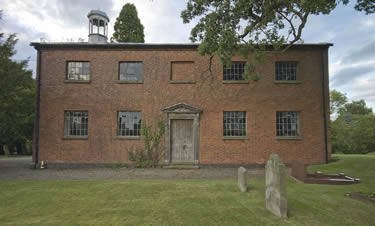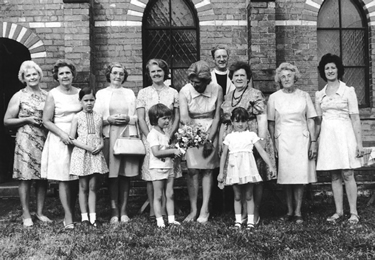Historical Background
The medieval parishes of Cheshire were very large in size, with one dominant village in which stood the parish church and many, sometimes twenty or more outlying townships, with no place of worship. If in addition the parish was overwhelmingly rural in character and lay alongside or even across county boundaries the sense of isolation and freedom from control could be very strong indeed. Such was the case with Threapwood in the extreme south-west of Cheshire, an extra-parochial liberty partly in Cheshire and partly in Flint.
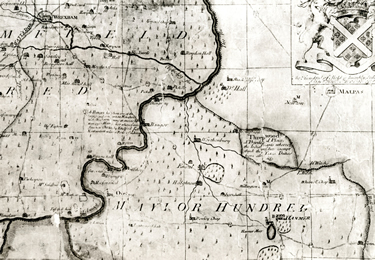 |
Map of 1742. The text says "Threpwood a privileged place the inhabitants whereof think themselves exempt from all taxes, dues etc." This situation still existed in 1773 - see below. |
The name itself means "disputed wood" i.e. disputed between two shires, and a traveler reported in 1773 that the place was really in no county, parish town or hamlet at all, no land taxes or rates were payable and no sheriff or constable or J.P. had jurisdiction therein. Certainly this "forgottenness" was a source of pride and profit. Names such as Frontier House, Holy Land and Paradise Brook suggest an idyllic way of life.
Parish of Threapwood
The Parish of Threapwood was formed formed out of the ancient Doomsday Forest of Broughton, portions of which had been annexed to the adjacent parishes of Malpas and Worthenbury, and comprised of an area 240 acres 1 rood 8 poles. Being ex-parochial it had formerly an unenviable notoriety as a refuge of immorality and lawlessness.The Parish of Threapwood transferred to the Diocese of St Asaph in 1852.The Flintshire part of the parish was transferred to the county of Cheshire in 1896.
St John the Evangelist Church Threapwood
It was around the turn of the 18th Century that the population of Threapwood had increased to around 450 inhabitants and it was felt that there was a need for a new Church for Divine Worship. 45 Parishioners signed a petition (most were illiterate and signed with a cross). Situated on the south side of the Paradise Brook, St John's Church was eventually built in 1815 on waste land belonging to Threapwood and consecrated on January 8th 1817 by the Bishop of Chester. The church yard was later consecrated on 1st Jan 1829 by Dr Sumner - Bishop of Chester.
St Johns was built at the expense of Lord Kenyon, Rev. Whitehall Whitehall Davies, T. Tyrwitt Drake, Francis Price and Anne Price. The first Wardens were Edmond Stokes (a maltster), and John Ledsom (an Inn Holder).
The Endowment consisted of £74-03-4d per annum (the interest from £2,024-15-9d). Parliamentary Grant (a grant of £1800 was made from this fund in1817) and Queen Anne's Bounty of £306-00-9 (this together with the glebe and the cost of erecting the church was given by L. Kenyon and Rev Whitehall Davies of Broughton). An endowment Trust and £106 Funded property with a house and 4 acres of glebe and was the patronage of the Bishop of Chester.
All the enclosed seats were charged an annual rent, amounting in the whole to £20.0.The two box pews numbered 2&3 were set apart for the use of Lord Kenyon and Whitehall Whitehall Davies (from Broughton Hall) and their heirs. Pew number 1 was designated for the use of the Curate. Seats numbered 21-30 were set apart for the use of the poor. In its original form the pews faced the centre of the Church and the pulpit was situated at the west end, against the present entrance door. The galleries at the west end and north and south were the property of Lord Kenyon and Whitehall Davies for the use of the poor children who were to be educated at any National School in or near Threapwood. They are approached from the stairs leading up from either side of the porch, at the top of which is a Sextons chair. St Johns has been described as having an extremely plain edifice with square windows.
The roof is of slate and built on to the west end of it is a pretty Bell Cupola of Gothic influence, in timber with a shallow dome. The Churchyard is to the north and south sides, many of the grave stones have been removed and grassed down. At the approach to the Churchyard is a fine pair of wrought iron gates and adjacent to the gravel path are one or two yew trees. The interior of the Church consists of plastered and painted walls and a quarry tiled floor. There are two box pews, in the north east corner is the Broughton Hall pew and in the south east corner is the one belonging to Lord Kenyon. The rest of the seating is of open wooden pews. The Altar Table is original, being set against a paneled Reredos containing in gold lettering The Lords Prayer, The Creed and The Ten Commandments. The Altar has an embroidered cover which is still remarkable in its beauty.
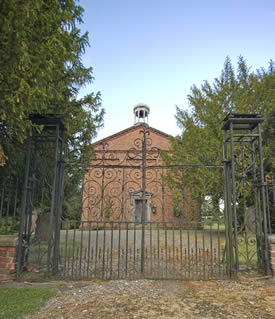 The wrought iron gates viewed from the West
The wrought iron gates viewed from the West
An oval shaped wrought iron kneeling rail surrounds the plinth upon which the Altar stands. The Pulpit is of carved oak and together with the fine Lectern gives the impression of being older than the Church; both have one or two arm brass candle holders, which look very well. The Harmonium that is regularly played has a highly decorated Victorian mahogany casing, but there is also a very much better table topped oak instrument that it is understood can only be played by extremely energetic use of the foot bellows.
Suspended from the ceiling is a magnificent pair of brass chandeliers of 8 lights, which, incidentally were stolen on 16 January 1984 and found two days later in an Ellesmere Antique shop. The Font is a curious stone columned one with a simple carved bowl. It is painted in a very curious flecking that makes it appear as though made of dark granite. There are two Memorial Tablets, one dedicated in 1883 to Thomas and Mary Green who for sixty years were closely connected with every Christian work in Threapwood. The other one is to the memory of William Gostage who was killed in action at Leewfortein, South Africa on 29 December 1961 aged 21 years. The Tablet was erected by his neighbours and friends.
The Calor Gas Lighting System was installed in 1947 and was by subscription in the Parish in Memory of Reverend Pembridge. Vicar 1918-1946. In 1997 Threapwood won the Best Kept Village Award in its category and were presented with a Field Maple tree which was planted in the Churchyard.
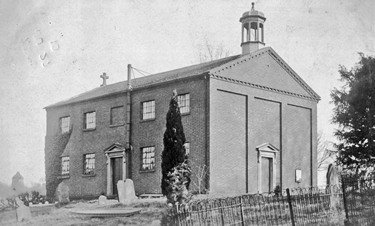 St Johns Church Threapwood c 1920
St Johns Church Threapwood c 1920
How St Johns might have changed
The following sketches show how St Johns Church might have been rebuilt if plans being drawn up in 1888 had been carried out. A footnote to the picture below reads; "The building in addition to being very ugly outside and even worse, inside is also in bad repair. The roof is positively dangerous and the building is acknowledged by all to be unworthy of repair".
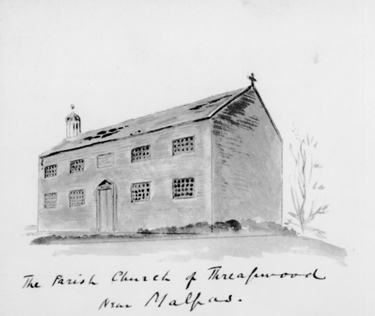 A sketch of St Johns circa Dec 1888
A sketch of St Johns circa Dec 1888
The sketch below shows how St Johns might have looked if a design by Messrs Douglas & Fordham of Chester had gone ahead at an estimated cost of £1,500.
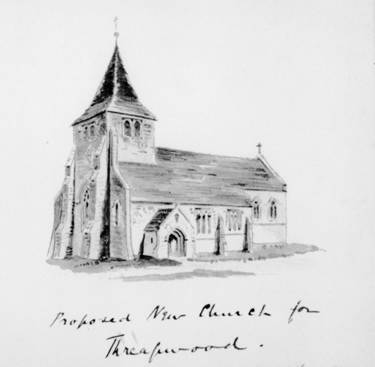 |
No one knows why the plans failed to go ahead. |
Vicars of St John's Threapwood.
| 1817 | R. P Brooke | |
| 1821 | William Barnes | |
| 1823 | Frederick Parry | |
| 1830 | George Cole | |
| 1831 | Thomas Bradford | |
| 1832 | John F Churton | See Below |
| 1839 | Maxwell Phayre | b. abt 1790 in Templeshannon, Co Wexford. Died 29 August 1856 in Passy, France. Son of Robert Phayre (b1764) and Amelia Holmes Pomeroy (c. 14 Jan 1761) Ballyhay, Co. Cork |
| 1854 | Thomas Cox | |
| 1886 | George Belchamber | |
| 1889 | Samuel George Wood | |
| 1894 | William Ellis | |
| 1907 | Malyn | |
| 1911 | Semon | |
| 1917 | Pembridge | |
| 1946 | Minchin | |
| 1962 | Canon T. M Rylands | |
| 1985 | T Etheridge | |
| 2011 | Canon Ian Davenport |
St John's Church Parish Records
A useful and interesting extract of Parish Burial Records has been made by family historian Trevor Ashley. The information compiled by Trevor is up to date and can be see by clicking here.
John Frederick Churton.
There exists a well researched connection between Threapwood and New Zealand via the Reverend John Frederick Churton (named in the table above) who was incumbent at Threapwood between 1832 and 1839 and who seems to have sponsored or employed local people some of whom accompanied him on the New Zealand Company ship Bolton, which left Gravesend in October 1839 and arrived in Wellington (then known as Port Nicholson) in April 1840.
Among the names of the emigrants are Thomas Graves, an unmarried agricultural labourer of thirty, Sarah Maddox, a sixteen year old servant and the Lowe family, father Griffith, his wife Ann and their five children, Edward who was twelve, Josey nine, Mary seven, John four, and William who was eighteen months old. It is not known whether the family survived the journey intact, however the dangers and difficulties of a seven month sea journey in the middle of the nineteenth century can only be imagined.
It is known that the Reverend Churton was employed as chaplain to the New Zealand Company and it is easy to imagine that he was instrumental in persuading some of his employees to accompany him on the hazardous journey to the Southern Hemisphere. It has to be noted that the Reverend Churton and his wife and children travelled as cabin passengers. Subsequently he was appointed Colonial Chaplain and first Incumbent of St Paul's Church in Auckland which was built by public subscription, including the sum of £14 and 6 shillings from his former parishioners at Threapwood.
This passage was hand written and found by Jane Bebbington (nee Pickering) amongst her late mother, Marjorie Pickering’s effects.
Jane adds that today St Paul's Church is the oldest established church in the city. The foundation Stone was laid on 28th July 1841 and the first service was held on 7th May 1843 and it served as Auckland’s cathedral for over 40 years. The Reverend John Churton was the first minister and occupied that role for 12 years. The Churton Memorial was built to his memory after he died on 26th January 1853.
The Churton Memorial, as it can be seen today, is in fact the second one built in his honour – two years after his death the first was built in Emily Place circa 1855 funded by public and military subscriptions. However, in 1879 the Auckland Harbour Board cut down Emily Place including demolishing the church and the memorial however, various plaques, tablets and the memorial slate were mothballed. In 1895 plans were drawn up to recreate the Emily Place Reserve and in 1900 the issue of the memorial was raised again and after some soul searching the original slate tablet was set into the base of a memorial drinking fountain and again a combination of public and council subscriptions funded the building of the memorial which was erected in 1908. The tablet is pictured below.
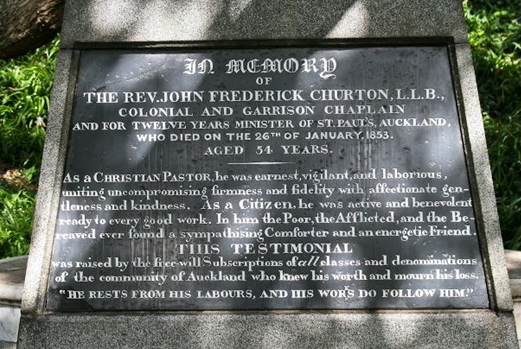 |
In 1968 the obelisk section became unstable and had to be temporarily removed. At a later stage in the twentieth century the drinking fountains were put out of service and filled in and today the Churton Memorial can be found amongst the mature pohutukawa trees that have grown up around it in the Emily Place Reserve. The obelisk is pictured right. There is also a brass plaque on the northern face of the memorial which commemorates the centenary of the laying of the foundation stone of the original St Paul's Church in 1841. Further details on the Churton family can be found in the "People" page. |
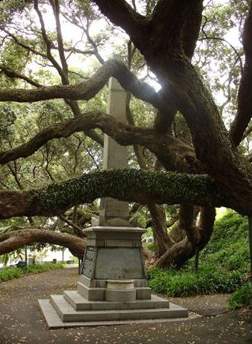 |
|
More
Parochial Church Council Minute Book 1924 - 1977
The minutes of the Parochial Church Council minute book give an interesting insight into the activities and issues that mattered to the people of Threapwood and in some cases, really mattered (see PCC Minutes below). The following extracts help to illustrate this;
1924 - Electoral Role amended to 78. It was decided to write to Whixall Band for tender to play at the annual fete from 6-10pm on June 25th or July 2.
Aug 11th - the question of having a surpliced choir was considered - it was decided that enquiries be made as to keen men suffice to number 26.
1925 - Annual fete - decided to write to Whixall Band for estimate to play from 3.30 to 10 on Wed June 17th.
Balance sheet of Annual Fete 17.06.1925
| Income | Expenditure | |||
| Gate and Tickets | £5.10.6d | Printing of Tickets and Bills | £0.7.4d | |
| Donations | £1.6.6d | Hire of Band 8 players | £4.12.9d | |
| Bran Tub | £0.19.8d | |||
| Minerals and Tea | £0.17.2d | |||
| Coconut and Fortune Telling | £0.16.5d | |||
| Surplus Tennis Entries | £0.2.0d | |||
| Rummage/Gollywogs/Roses | £1.16.5d | |||
| Ice Cream | £0.12.0d | |||
| Total | £12.0.8d | Total | £5.0.3d | |
| Balance | £7.0.5d | |||
| £12.0.8d |
Aug 27th The Sunday School Treat (also a dance for raising funds for Church expenses) was discussed. It was decided to hold both events in Mr Freeman's grounds on Sept 16th.
1926 - Friday Dec 10th - a dance was held in Worthenbury Young Men's Institute for the purpose of raising money to buy material for a sale of work to be held in Feb. The proceeds from this Sale of Work to be for Church expenses. The sum of £5-01-3 was raised. Feb 22nd a Sale of Work Tea Dance was held at Tallarn Green Hut. The proceeds amounting to £15 approx.
1938 - Meeting of the P.C.C. held in the school at 6pm Mon Sep 5th.
Present - The Vicar in the chair, The church wardens, messers E Broad & F Young, Mrs Shillum, Mrs Stringer, Mrs Mercer, Mrs Freeman also Mr & Mrs Taylor and Mrs James.
The meeting was opened with a prayer.
The vicar stated that the meeting had been called to hear some complaints. He hoped that as a result the differences and misunderstandings may be removed. Mr Taylor then stated that in August Mrs Taylor had been asked by Mrs E Broad to do the alter flowers and that in Aug Mrs Taylor went to the church at 5 to 6 and it was not open, having asked Mrs James to have it open. She was told it would be opened in her (Mrs James's time) that Mrs James was abusive. Mr Taylor met James near the church and James used abusive language and wanted to fight. The flowers were done later. He further stated that the church was not well cleaned, the gallery being very dusty and a lot of rubbish in one pew, also a scythe was on the stairs to the gallery. That Mrs James interfered with the flowers at Christmas, that some jam was missing at the Harvest Festival.
A good deal of irrelevant talk relating to outside matters was indulged in, the statement had been made that Mr Taylor had been kicked out of office was disposed of by the vicar who said that after as a church warden desired to retire and at the next Vestry meeting another warden was appointed. A number of the council stated that the jam was misplaced and was found. Mr and Mrs Taylor then retired also Mr and Mrs James. The council then considered the complaints and thought that the church was well cleaned, that as the gallery was never used that it naturally was not dusted as often as the rest of the church, that the matter of the scythe was not important as it was only stored near the bier while the yard was being mown, they considered the yard was very well kept. The Council considered that the use of bad language was indefensible.
C.R. Pembridge - Vicar
1942 - it was decided to get a new stove put in as the old one was not repairable.
1947 - Plans were made for the service of "coalition" for the new Vicar on 25th June Rev Minchin, following the death of Rev Pembridge. The Bishop of Chester, his officers, guests and parishioners who attended the service were to be entertained in the school room afterwards. Mrs Symonds to be in charge of refreshments, unfortunately though the Ministry of Food, who had been approached for the permission to purchase rationed goods, had refused so it was decided that the only parishioners to be invited would be the members of the P.C.C. members of the Ladies committee and any helpers.
It was proposed that money for the payment of the quota be raised by a whist drive and dance. After discussion it was agreed that money from such a source should not be used in the Church or the Church grounds and that therefore it should be accounted in a separate fund and only used for the payment of the quota, purchase of stationery, postage stamps and such other purposes.
While ill in hospital the Rev Pembridge had received a cheque from the church but he died before it was cashed. His daughter returned it saying that perhaps it could be used for a memorial. The P.C.C. planned a tablet but the Consistory Court had rejected this (words or page missing?) extension of the Church Yard.
1967 - P.C.C. approved the Union of benefices of Malpas and Threapwood should go ahead.
1968 - Estimate from Chesworth of Malpas £130 to redecorate and treat beams was accepted. A new stove costing £45 paid for.
29:8:68 - United Benefices. Pte Diggory South Wales Borderers died.
These notes had been hand written by an unknown source and have been replicated as written by David Paton who has access to the original copy.
Threapwood Chapel
The following text provided by local resident Stuart Howarth has been edited from an article by Revd. Dr. Ian Sellers in the Magazine of the Congregational History Circle; Volume 3 Number 2 pp.6-9; Spring 1994.
The growth of Nonconformity
Conditions in Threapwood were ripe for the growth of radical nonconformity, though, oddly enough, the first Congregational lodgement was secured in Malpas itself which was planted from Chester in 1814, a church being founded seven years later. Another thrust of evangelistic activity came through the efforts of Thomas Hitchin, a disciple of the great Cheshire evangelist Job Wilson who planted Tattenhall in 1810 and Barton in 1816. The Malpas church enjoyed the powerful ministry of the Rev H Birch (1828-34) and it was during his pastorate that missionary work was extended to Threapwood in 1833. In June of that year the upper room of an unoccupied malt kiln was taken at a rental of £1 a year. A congregation of about fifty was quickly gathered, together with a Sunday school of a similar number. Threapwood obviously liked round numbers, for in July 1850 a room known as "The Wood Chapel" was erected for £120, to seat 120 persons. The work had progressed slowly: by this date average attendances of sixty were being reported.
Links to Malpas
Threapwood was worked jointly with Malpas, and very generous subventions from the County Union, one of who's "stations" or "aided churches" it became. F.J. Powicke remarks that regarding these south-west Cheshire churches the Union was prepared to be particularly generous, as it recognised that they lay in wholly agricultural districts where bad harvests and social or ecclesiastical influence could militate against success or even survival. It is interesting to note that the minutes of the Malpas church show that the pastor in the later 19th century enjoyed a special perk in addition to his stipend - a pony and trap to convey him to Threapwood and back.
Building of Threapwood Chapel
Threapwood Chapel appears to have been built in 1850 as an Independent Congregational Chapel. At some point a Manse for the Minister was also constructed.
In 1874, a date when unusually the membership at Threapwood was actually larger than that at Malpas, a new, enlarged freehold church was erected on the site of the 1850 building. By this date a Congregational layman of wealth, industry and great generosity was beginning to make his mark on the local scene. Mr. Thomas Huxley of Malpas came from a family well-known in the farming, wheelwrighting and building life of the community. Not only did Mr. Huxley give generously to Malpas and Threapwood: he founded at his own expense several new churches. Norbury Common, a very remote spot, was planted in 1868: this too received considerable help from the County Union. Bradley where cottage meetings had been held since 1851 was presented with its neat, Gothic-style chapel in 1891.
The Rock, Farndon, had been founded two years earlier and cottage meetings in Chorlton Lane, mainly for children's work, were similarly encouraged, though premises were not erected here till five years after Mr Huxley's death. The latter which occurred on August 11th 1903 was a severe blow not only to Congregationalism but also to the Free and Primitive Methodists to whom he was similarly well disposed.
A Directory of Cheshire 1874, probably compiled in 1873, confirms that Threapwood at that time had "a place of worship for Independents, erected in 1850". In 1873 they joined The Congregational Union with Malpas.
On 5 July 1873; Teachers and scholars of the Threapwood Congregational Chapel Sunday School were served tea by Mr Edward Broad. Afterwards, oranges, nuts and sweets were scrambled for. The children sang at a meeting in the evening when the Minister, the Rev. J.L Jones, gave an address.
October 10; A harmonium had been introduced recently into the Chapel. Collections were being taken at services to pay for it.
April 4 1874; The friends of the Chapel had met on the previous Wednesday, to lay the foundation stone of a new Chapel at Threapwood. The site chosen was said to be where the old Chapel stood, though enlarged by taking a piece of the adjoining land. The Pastor, the Rev. J.L Jones officiated. Mr Thomas Huxley, the senior deacon from Malpas, presented a silver trowel to Richard Jones Esq of Chester, who fixed the stone. Further stones were laid by John Roberts on behalf of his uncle, Robert Roberts of Cuddington and Mrs E Broad. The Rev. T. Robinson delivered an inaugural address. A full report of the Stonelaying ceremony was carried in a Chester Chronicle report of 18 April 1874 which can be read by clicking here (Courtesy Stuart Howarth).
September 26 1874; On the previous Wednesday, the new Congregational Chapel had been open for divine worship at Threapwood. It was said to stand on the site of the old Chapel and was described as being of red and white brick with stone dressings. The style of architecture was gothic, with an apse and raised platform at the east end for the clerk and a small vestry on the north side. It had sitting accommodation for 100 persons. Mr Huxley of Malpas was both architect and builder. The cost was about £300.0
Thomas Huxley was born in 1820 and died in 1903 aged 82 years. He founded Tom Huxley Builders of Malpas and had their office and yard on Tilston Road in Malpas directly adjacent to the Infant School. He was a wheelwright by trade but became a builder and an architect where he seemed to specialise in building and/or refurbishing many chapels within quite a wide area and many of them have a distinctive round window with 10 leaves.
It appears that he started with Norbury and Woolerton Congregational Chapels in 1868 and then Tattenhall Congregational Chapel and the rebuilding the Whixall Congregational/URC Chapel in 1870 - then in 1873 he built the Wesleyan Chapel at Baschurch - in 1874 he refurbished Threapwood Congregational Chapel - in 1875 he built Hampton Primitive Methodist Chapel - in 1878 he built Barton Congregational Chapel - in 1889 he built Farndon (The Rock) Congregational Chapel - in 1890 he built Lavister Congregational Chapel - in 1891 he built Bradeley Congregational Chapel - in 1905 the Chorlton Lane Mission Room was built posthumously in his name as he was actively involved with the movement from as early as 1850 and acted as their leader for most of those years.
Thomas Huxley worshipped at the Congregational Chapel on Wrexham Road in Malpas but there does not seem to any record of his involvement there with any building work. He is reported to have been a very committed member of the local Oddfellows Chapter. There is also some reference to him being involved with chapel communities in Mold, Holywell, Buckley and Shotton in North Wales! These facts are all taken from an article by Reverend Nigel Lemon who reports that Thomas Huxley was a very generous man who encouraged subscribers to fund the developments of these listed chapels as well as loans by himself and indeed acted as a banker to many of them with very lenient repayment charges and terms! Many of these chapels became school rooms and/or acted as village meeting rooms and Thomas himself was involved with a Congregational Day School for over 50 years. He died in 1903 and his 'Estate' was valued at £13,880 which would have been the sign of a very successful man in those days - this was divided equally amongst his 8 grandchildren.
May 5 1875; On the occasion of a farewell service for the Pastor, the Rev J.L Jones, who was moving to Witney, Oxfordshire, one of the speakers referred to the Chapels' history. He said it had been reared in 1850 when there were 15 members. Since then the fortunes of the place had ebbed and flowed as different ministers had come and gone, but the Chapel was now prospering, with four times as many members as two years earlier. In the early years of the last century the Chapel still flourished under the Ministry of Mr Everett. It is believed that the Minister who was resident in the adjoining Manse in the 1940's was Mr Griffiths. There was a well-attended Sunday School still active at that time.
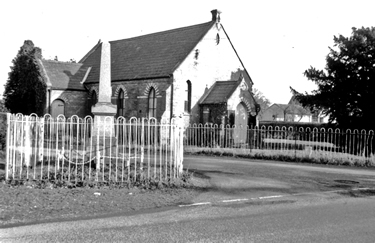 |
Threapwood Chapel pictured in 1985 before conversion to a domestic dwelling with the WW1 War Memorial in the foreground. |
Local Congregational Links
Malpas, Threapwood, Norbury, Bradley and Chorlton formed a neat circuit of churches, the first two customarily linked, the other three less intimately associated with their two sisters of older foundation. From the 1890s in fact the Congregational Year Book often records them as under "lay agency", or as "supplied". That all five churches were maintaining a vigorous witness during the Edwardian period is shown by the returns of 1912: Malpas 49 members plus 43 children, Threapwood 40 members and 35 children, Bradley 20 members and 35 children, Chorlton no members but 45 children, Norbury 12 members and 50 children.
The First World War imposed strains on the relationship between Malpas and Threapwood, and after 1918 the two causes went their separate ways. Threapwood brought the three smaller chapels within its orbit, and secured the services of a number of very energetic lay pastors - Mr. L. Everett from 1919 to 1935, Mr J.A. Hopwood (actually a retired minister) from 1938 to 1940, and Mr. E.T. Griffiths from 1941 till his death in 1955. Conditions now were becoming difficult. By 1939 Threapwood and Chorlton Lane had only 23 members between them, Bradley and Norbury a mere ten. Somehow they all survived the Second World War and into the 1958, but thereafter decline was rapid. Threapwood and Bradley bravely held on, largely thanks to the faithful service of lay preachers, Congregational and Methodist alike. Those who took services still recall being rewarded for their labours with gifts of eggs, fruit, potatoes etc. Chorlton and Norbury were lost however, the former closing in 1956, the latter ten years later.
Ministers
The following is an incomplete list of Ministers who in some cases had responsibility for other local Chapels.
| 1892 - 1895 | Thomas Nicholas | |
| 1904 - 1913 | William Plasket | |
| 1916 - 1918 | Charles William Hall | |
| 1918 - | William Ellis Holt (with Malpas) | |
| 1920 - 1935 | Everett | |
| 1938 - 1940 | John Albert Hopwood (with Chorlton Lane) |
Closure
Malpas, Threapwood and Bradley, with 31, 5 and 12 members respectively, were all confronted in 1972 with the painful choice as to whether their future lay inside or outside the new United Reformed Church. All three chose differently. Malpas, after changing its collective mind at least twice, eventually chose the UR option. It is now a joint URC/Methodist church, the one free church in what is still a very Anglican parish, though the Methodists now far outnumber the surviving Reformed element.
Threapwood opted for the Congregational Federation. It was now in a rather weakened state subsisting largely on the income from hiring out its premises for local community functions. Services ended in the early 1980s, and the building was sold and converted for domestic use in 1988. Although a sad loss to some local people it was simply too remote and its congregation too aged and scattered to sustain a viable church presence any longer.
There seem to be few photographs of the Chapel interior during its time as a place of worship, however a small number of photographs were taken in the period after its closure and before redevelopment took place. These are reproduced below courtesy of Stuart Howarth.
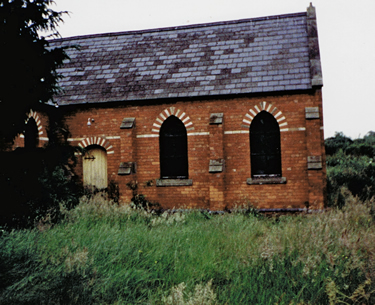 |
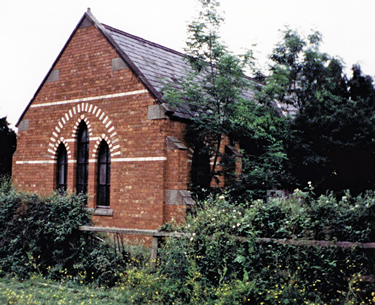 |
|
| View from the South | View from the East | |
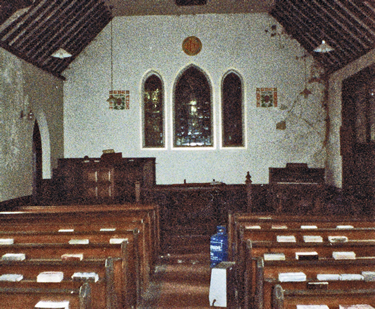 |
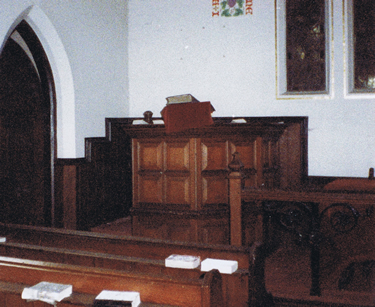 |
|
| View of Pulpit and Alter | Pulpit | |
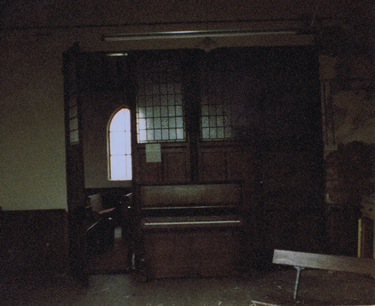 |
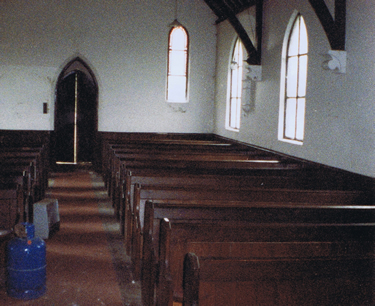 |
|
| Piano | View towards entrance | |
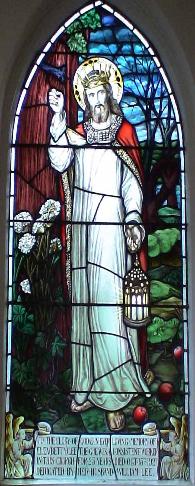 |
This window from Threapwood Chapel was based on Holmen Hunt's "Light of the World". The original painting can be found in Keble College, Oxford. The window was removed from the chapel at the time of its conversion to a domestic dwelling (circa 1988) and later installed in Tallarn Green Methodist Chapel. |

